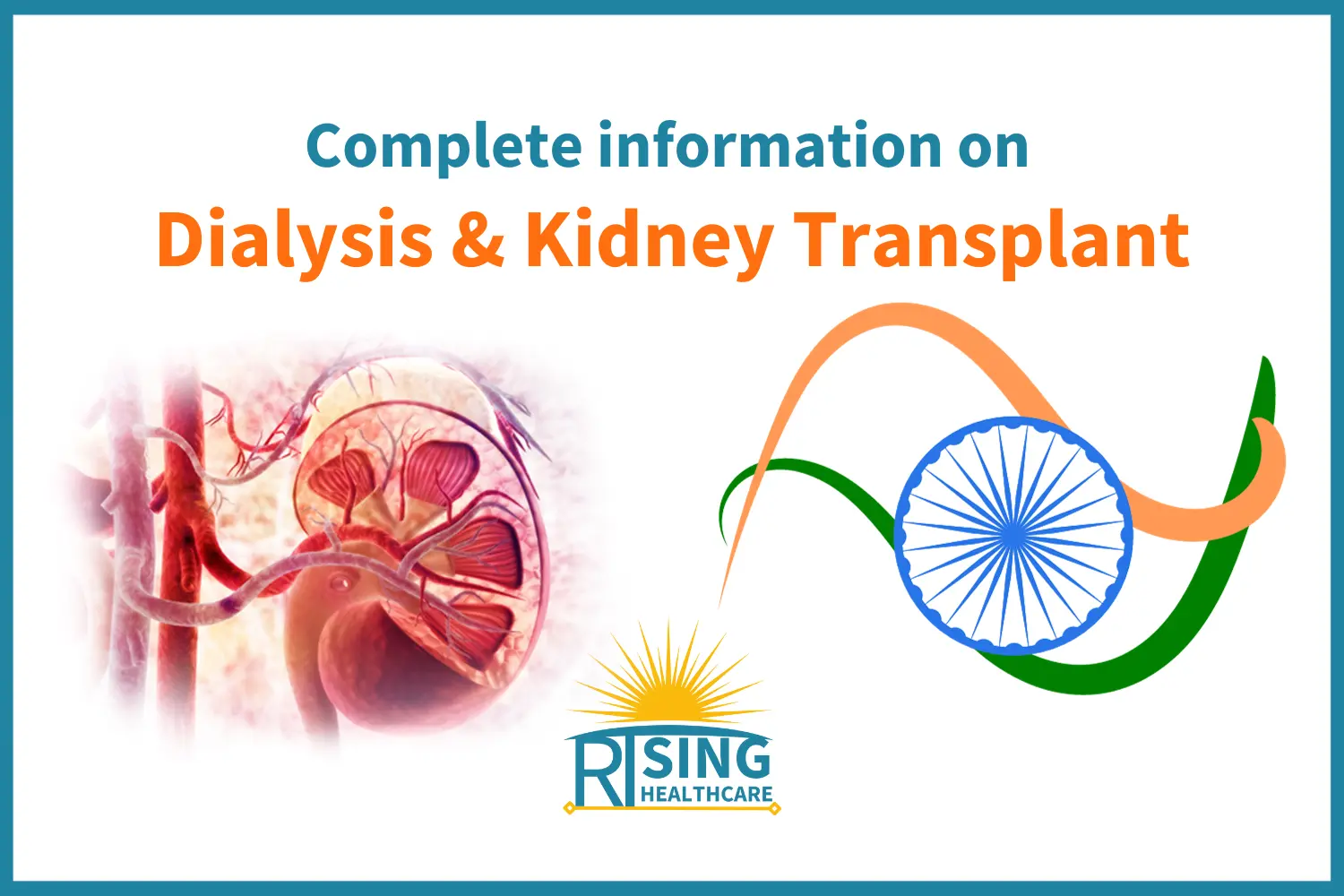
Dialysis and Kidney Transplant: Lifelines for Ailing Kidneys
Introduction
Our kidneys play a crucial role in maintaining our overall health. They filter out waste and excess fluids from our blood, ensuring that our bodies function properly. However, when our kidneys become damaged or fail to work as they should, it can lead to serious health issues. In such cases, medical interventions like dialysis and kidney transplants become lifesaving options. In this article, we’ll explore what dialysis is, when it’s required, and how it relates to kidney transplants.
Dialysis When Required
a. Understanding Kidney Function
Before delving into when dialysis is required, let’s grasp the importance of our kidneys. These bean-shaped organs, located just below the ribcage, filter blood and remove waste products and excess fluids through urine. They also help regulate blood pressure, produce red blood cells, and maintain the balance of essential minerals in the body.
When kidneys are damaged due to various factors such as chronic kidney disease (CKD), high blood pressure, diabetes, or infections, their ability to perform these functions diminishes. This can lead to a buildup of waste and fluids in the body, causing various symptoms and complications.
b. Signs That Dialysis May Be Needed
Dialysis becomes necessary when the kidneys are no longer capable of effectively carrying out their filtering functions. Some common signs that may indicate the need for dialysis include:
- Severe Fatigue: Kidney failure can result in anemia, causing extreme tiredness and weakness.
- Swelling: A buildup of fluids can lead to swelling in the legs, ankles, and around the eyes.
- Shortness of Breath: Excess fluid in the lungs may cause difficulty in breathing.
- Nausea and Vomiting: The accumulation of waste products in the body can cause nausea and vomiting.
- High Blood Pressure: Kidney disease can elevate blood pressure, making it difficult to manage.
- Changes in Urination: This includes reduced urine output or foamy, bloody, or dark-colored urine.
- Itchy Skin: Excess waste in the bloodstream can lead to itchy skin.
- Loss of Appetite: Kidney disease can result in a metallic taste in the mouth and a loss of appetite.
c. Stages of Kidney Disease and Dialysis
Kidney disease progresses through stages, with the severity determining the necessity and timing of dialysis. The stages of kidney disease are typically classified as follows:
- Stage 1-2: Mild kidney damage with few or no symptoms; usually managed with medications and lifestyle changes.
- Stage 3-4: Moderate to severe kidney damage; may involve dietary adjustments and medication management.
- Stage 5: End-stage renal disease (ESRD), where the kidneys are no longer able to function adequately. This is when dialysis becomes a lifeline.
Dialysis Kidney Transplant
a. What is Dialysis?
Dialysis is a medical procedure that replicates some of the essential functions of the kidneys when they fail to perform adequately. It involves the use of a machine to filter and clean the blood, removing waste products and excess fluids. There are two primary types of dialysis:
- Hemodialysis: In this method, a machine called a dialyzer is used to filter the blood. A special access point, usually a vascular access or fistula, is created to facilitate blood flow to the machine. Hemodialysis is typically done at a dialysis center or hospital and usually requires multiple sessions per week.
- Peritoneal Dialysis: This form of dialysis uses the lining of the abdominal cavity (peritoneum) as a natural filter. A special fluid called dialysate is introduced into the abdominal cavity through a catheter, which helps remove waste and excess fluid. Peritoneal dialysis can often be done at home, offering more flexibility to patients.
b. When is Dialysis Required?
Dialysis is required when the kidneys are no longer able to maintain the body’s internal balance of fluids and electrolytes, remove waste products effectively, and regulate blood pressure. As mentioned earlier, this typically occurs in the end-stage renal disease (ESRD) stage, which is the final stage of chronic kidney disease.
The decision to initiate dialysis is based on various factors, including the patient’s overall health, symptoms, and laboratory test results. The timing can vary from person to person, but it’s generally recommended when:
- The glomerular filtration rate (GFR), a measure of kidney function, falls below 15 mL/min.
- There are severe symptoms and complications of kidney failure, such as dangerously high potassium levels or fluid overload.
- The patient’s quality of life is significantly affected by kidney disease symptoms.
Dialysis does not cure kidney disease but helps manage its symptoms and maintain the body’s internal balance. It is often a bridge to other treatments, such as kidney transplantation.
c. Kidney Transplant: A Permanent Solution
While dialysis is a life-sustaining treatment, it is not a permanent solution. Many individuals with ESRD opt for a kidney transplant as a long-term solution to replace the failed kidneys. Kidney transplantation offers several advantages over ongoing dialysis:
- Improved Quality of Life: After a successful kidney transplant, patients can often return to a more normal lifestyle with fewer dietary restrictions and a reduced need for medications.
- Better Survival Rates: Generally, kidney transplant recipients tend to have higher survival rates and a longer life expectancy compared to those on long-term dialysis.
- No Dialysis Sessions: A successful transplant eliminates the need for regular dialysis sessions, offering greater freedom and flexibility.
Dialysis Transplant
- a. The Role of Dialysis Before TransplantBefore a kidney transplant can take place, patients with ESRD usually undergo dialysis. This serves several purposes:
- Pre-transplant Preparation: Dialysis helps manage the patient’s condition while they await a suitable donor kidney. This preparation includes keeping the patient in the best possible health to undergo surgery.
- Filtering Harmful Substances: Dialysis continues to filter waste products and excess fluids from the body, preventing further complications while on the transplant waiting list.
- Minimizing the Risk of Rejection: A kidney transplant recipient must take immunosuppressive medications to prevent the body from rejecting the new organ. Dialysis can help clear any pre-existing antibodies that might increase the risk of rejection.
b. The Transplant Procedure
A kidney transplant involves surgically placing a healthy kidney from a living or deceased donor into the recipient’s body. The new kidney typically goes into the lower abdomen, where it is connected to the recipient’s blood vessels and bladder.
- Living Donor Transplants: In some cases, a living donor (usually a family member or close friend) may donate one of their kidneys. Living donor transplants tend to have better outcomes because the donor is carefully screened, and the recipient receives a healthy, well-matched kidney.
- Deceased Donor Transplants: If a living donor is not available or suitable, patients may receive a kidney from a deceased donor. These organs are allocated based on a complex system that considers factors like blood type, tissue matching, and waiting time.
c. Life After Kidney Transplant
After a successful kidney transplant, patients need to follow a lifelong regimen of medications to prevent rejection and ensure the new kidney functions properly. These medications suppress the immune system to prevent it from attacking the transplanted organ. While these drugs come with their own set of side effects, they are a small price to pay for the improved quality of life and increased lifespan a transplant offers.
Regular medical check-ups and monitoring are essential for transplant recipients to ensure the kidney remains healthy and that there are no signs of rejection or complications.
Conclusion
In conclusion, dialysis and kidney transplantation are two critical medical interventions that come into play when our kidneys fail to perform their essential functions. Dialysis, whether hemodialysis or peritoneal dialysis, helps manage the symptoms and maintain the body’s internal balance when the kidneys are no longer able to do so. Kidney transplantation, on the other hand, provides a long-term solution for individuals with end-stage renal disease (ESRD), offering a better quality of life and improved survival rates.
The decision of when to initiate dialysis and whether to pursue a kidney transplant is a complex one that depends on individual circumstances and medical evaluations. Both treatments have their advantages and disadvantages, and the choice often boils down to what will best suit the patient’s unique needs and preferences.
Ultimately, the goal of these interventions is to offer hope and a chance at a healthier, longer life to those grappling with kidney disease. Advances in medical technology and organ transplantation continue to improve the outlook for individuals facing kidney-related challenges, providing a brighter future for many.

